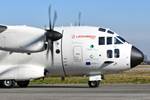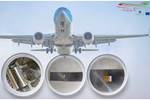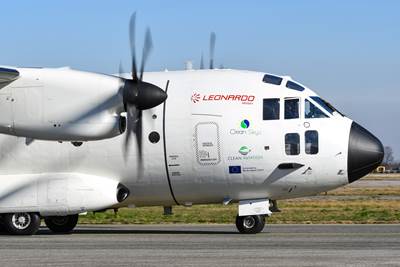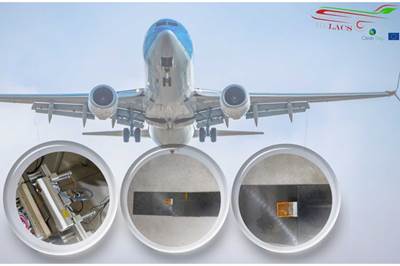SOLIFLY project proves viability of composite multifunctional energy storage within aircraft structures
Clean Sky 2 demonstrates key integration aspects of multifunctional structural batteries for electrified aircraft lightweighting, paving the way for further maturation in follow-on projects.
Structural battery cells following the two concepts studied in SOLIFLY. AIT’s reinforced multilayer stack (RMS, left) and UNIVIE’s coated carbon fibers (CCF, right). Source | Alexander Beutl (left) and Qixiang Jiang (right)
What if you could unify electric battery technology with aircraft structures to save weight? This was the premise behind Clean Sky 2’s “Semi-SOlid-state LI-ion batteries FunctionalLY integrated in composite structures” (SOLIFLY) project, which ran from January 2021 until December 2023. The recently concluded 3-year project successfully investigated the feasibility of multinational “structural batteries,” which can be used in aerostructures to carry mechanical load while also storing electrical energy. Partners demonstrated such capabilities in the production of an aeronautical-grade, high-strength, multifunctional composite stiffened panel which incorporates 20 integrated structural battery cells.
“Integrating the batteries in the aircraft structure increases the overall power density performance saving weight, hence reducing the emissions,” says Jimmy Tchen, Clean Aviation project officer.
To attain SOLIFLY’s goals, project coordinator AIT Austrian Institute of Technology GmbH (Vienna), in collaboration with the University of Vienna (UNIVIE) developed a novel structural electrochemistry formulation based on high-energy materials combined with a safe, semi-solid structural electrolyte. This electrochemical formulation is reported to be scalable and compatible with aeronautic composite materials and manufacturing processes, including curing in an autoclave. Two cell concepts with different degrees of integration were developed (image above).
The concept proposed by UNIVIE uses carbon fibers as current collectors, whereas AIT’s concept reinforces the cell active components mechanically and builds upon well-established battery cell manufacturing processes.
Additionally, ONERA, the French Aerospace Lab (Palaiseau), developed an integration concept for solid composite laminates using a numerical framework that not only evaluated and minimized the impact of the structural cell on the multifunctional structure’s mechanical properties but also evaluated the onset of damage; this is an important aspect when it comes to their certifiability. Manufacture of multifunctional composites was also addressed, including the handling of battery cells in an out-of-laboratory environment and the achievement of fully cured composites with still-functional battery cells. To demonstrate the SOLIFLY technology, a stiffened panel was selected as it is a standard high-strength aircraft component. The SOLIFLY multifunctional demonstrator, which incorporates 20 structural battery cells, was tested at ONERA with the use of multi-instrumentation.
The SOLIFLY demonstrator of an aero-grade, high-strength, multifunctional stiffened panel integrating 20 structural battery cells in its skin. Source | Frédéric Laurin
CustomCells Itzehoe GmbH (Itzehoe, Germany), an SME specializing in energy storage, UNINA (Universita degli studi di Napoli Federico II, Naples, Italy) and CIRA, the Italian Aerospace Research Centre (Capua, Utaly) evaluated the feasibility aspects of the technology’s manufacture, certification and potential upscale at aircraft level. Concurrently, an industrial advisory board, made up of experts from Piaggio Aerospace, Pipistrel, FACC and Dassault Aviation, provided input and guidance while monitoring the project’s progress.
One of the key challenges in the structural electrochemistry’s development was the need to create a thermoplastic-based structural electrolyte. The initially intended epoxy-based system demonstrated fundamental issues that could not be resolved within the project’s timeframe. In order to manufacture multifunctional structural battery carbon fiber composites in an autoclave, it was necessary to adapt the curing cycle in order to maintain the battery cell functionality while ensuring that the carbon fiber was still fully cured.
SOLIFLY results, though still at low technology readiness levels (TRL), indicate that several hundred kilowatt-hours of electric energy could potentially be stored using structural batteries in future regional and short-/medium-range aircraft. These structural batteries could supply electric energy to secondary loads, such as passenger infotainment, cockpit avionics, or more energy-demanding systems, including e-taxiing (moving the aircraft between the terminal gate or stand and the runway without using a tug or engine thrust).
According to partners, SOLIFLY could even contribute to hybrid-electric propulsion of smaller aircraft, at reduced weight, without affecting the aircraft’s center of gravity or reducing usable volume. The implementation of hybrid-electric propulsion and e-taxiing has the potential to reduce the environmental impact of aircraft by reducing fuel burn. Furthermore, e-taxiing has the additional benefit of reducing noise on the ground, thereby improving local air quality and social acceptance in and around airports.
“We have been able to demonstrate that multifunctional energy storage is feasible without compromising the structural requirements of aerospace applications,” says Dr. Helmut Kühnelt, senior research engineer, electric vehicle technologies at AIT. “We now have a much better understanding of the potential of the technology, but also of the research needs and the challenges that lie ahead. But they seem to be more surmountable than before.”
SOLIFLY has prepared the ground for the follow-up project MATISSE (also coordinated by AIT), funded under Horizon Europe, which started in September 2022 and runs until August 2025. MATISSE will improve the multifunctional performance of structural batteries, extend their structural integration to sandwich composites, make them smart by adding integrated sensing capabilities and study the impact loading of multifunctional composite structures. The project will also demonstrate the technology at full scale in a multifunctional wingtip for the Pipistrel Velis Electro light aircraft, aiming to achieve TRL4 by the end of the project.
Furthermore, AIT has been awarded with a research grant from the U.S. Air Force’s European Office of Aerospace Research and Development to improve the multifunctional performance and life of aeronautic structural batteries. The project is ongoing until November 2025.
Related Content
A new era for ceramic matrix composites
CMC is expanding, with new fiber production in Europe, faster processes and higher temperature materials enabling applications for industry, hypersonics and New Space.
Read MoreThe potential for thermoplastic composite nacelles
Collins Aerospace draws on global team, decades of experience to demonstrate large, curved AFP and welded structures for the next generation of aircraft.
Read MorePEEK vs. PEKK vs. PAEK and continuous compression molding
Suppliers of thermoplastics and carbon fiber chime in regarding PEEK vs. PEKK, and now PAEK, as well as in-situ consolidation — the supply chain for thermoplastic tape composites continues to evolve.
Read MorePlant tour: Middle River Aerostructure Systems, Baltimore, Md., U.S.
The historic Martin Aircraft factory is advancing digitized automation for more sustainable production of composite aerostructures.
Read MoreRead Next
“Structured air” TPS safeguards composite structures
Powered by an 85% air/15% pure polyimide aerogel, Blueshift’s novel material system protects structures during transient thermal events from -200°C to beyond 2400°C for rockets, battery boxes and more.
Read MoreLeonardo advances sustainable aerospace innovation testing
Wingtips and morphing winglets integrated into a C-27J flying test bed, and a full-scale composite fuselage, are undergoing testing for Clean Sky 2 programs.
Read MoreAitiip Technology Center reports dismantling of thermoplastic parts using resistance welding
Clean Sky 2 HELACS project aims to enable improved recycling of composite components at aircraft end of life.
Read More




























